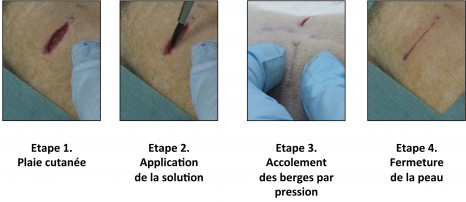There was a lot of excitement (one might almost call it giddiness) earlier this week about a new technique from Irish researchers for producing graphene. From an April 20, 2014 article by Jacob Aron for New Scientist (Note: A link has been removed),
First, pour some graphite powder into a blender. Add water and dishwashing liquid, and mix at high speed. Congratulations, you just made the wonder material graphene.
This surprisingly simple recipe is now the easiest way to mass-produce pure graphene – sheets of carbon just one atom thick. The material has been predicted to revolutionise the electronics industry, based on its unusual electrical and thermal properties. But until now, manufacturing high-quality graphene in large quantities has proved difficult – the best lab techniques manage less than half a gram per hour.
“There are companies producing graphene at much higher rates, but the quality is not exceptional,” says Jonathan Coleman of Trinity College Dublin in Ireland.
Coleman’s team was contracted by Thomas Swan, a chemicals firm based in Consett, UK, to come up with something better. From previous work they knew that it is possible to shear graphene from graphite, the form of carbon found in pencil lead. Graphite is essentially made from sheets of graphene stacked together like a deck of cards, and sliding it in the right way can separate the layers.
Rachel Courtland chimes in with her April 21,2014 post for the Nanoclast blog (on the IEEE [Institute of Electrical and Electronics Engineers]) website (Note: A link has been removed),
The first graphene was made by pulling layers off of graphite using Scotch tape. Now, in keeping with the low-tech origins of the material, a team at Trinity College Dublin has found that it should be possible to make large quantities of the stuff by mixing up some graphite and stabilizing detergent with a blender.
The graphene produced in this manner isn’t anything like the wafer-scale sheets of single-layer graphene that are being grown by Samsung, IBM and others for high-performance electronics. Instead, the blender-made variety consists of small flakes that are exfoliated off of bits of graphite and then separated out by centrifuge. But small-scale graphene has its place, the researchers say. …
An April 22, 2014 CRANN (the Centre for Research on Adaptive Nanostructures and Nanodevices) at Trinity College Dublin news release (also on Nanowerk as an April 20, 2014 news item) provides more details about the new technique and about the private/public partnership behind it,
Research team led by Prof Jonathan Coleman discovers new research method to produce large volumes of high quality graphene.
Researchers in AMBER, the Science Foundation Ireland funded materials science centre headquartered at CRANN, Trinity College Dublin have, for the first time, developed a new method of producing industrial quantities of high quality graphene. …
The discovery will change the way many consumer and industrial products are manufactured. The materials will have a multitude of potential applications including advanced food packaging; high strength plastics; foldable touch screens for mobile phones and laptops; super-protective coatings for wind turbines and ships; faster broadband and batteries with dramatically higher capacity than anything available today.
Thomas Swan Ltd. has worked with the AMBER research team for two years and has signed a license agreement to scale up production and make the high quality graphene available to industry globally. The company has already announced two new products as a result of the research discovery (Elicarb®Graphene Powder and Elicarb® Graphene Dispersion).
Until now, researchers have been unable to produce graphene of high quality in large enough quantities. The subject of on-going international research, the research undertaken by AMBER is the first to perfect a large-scale production of pristine graphene materials and has been highlighted by the highly prestigious Nature Materials publication as a global breakthrough. Professor Coleman and his team used a simple method for transforming flakes of graphite into defect-free graphene using commercially available tools, such as high-shear mixers. They demonstrated that not only could graphene-containing liquids be produced in standard lab-scale quantities of a few 100 millilitres, but the process could be scaled up to produce 100s of litres and beyond.
…
Minister for Research and Innovation Sean Sherlock, TD commented; “Professor Coleman’s discovery shows that Ireland has won the worldwide race on the production of this ‘miracle material’. This is something that USA, China, Australia, UK, Germany and other leading nations have all been striving for and have not yet achieved. This announcement shows how the Irish Government’s strategy of focusing investment in science with impact, as well as encouraging industry and academic collaboration, is working.”
Here’s a link to and a citation for the researchers’ paper,
Scalable production of large quantities of defect-free few-layer graphene by shear exfoliation in liquids by Keith R. Paton, Eswaraiah Varrla, Claudia Backes, Ronan J. Smith, Umar Khan, Arlene O’Neill, Conor Boland, Mustafa Lotya, Oana M. Istrate, Paul King, Tom Higgins, Sebastian Barwich, Peter May, Pawel Puczkarski, Iftikhar Ahmed, Matthias Moebius, Henrik Pettersson, Edmund Long, João Coelho, Sean E. O’Brien, Eva K. McGuire, Beatriz Mendoza Sanchez, Georg S. Duesberg, Niall McEvoy, Timothy J. Pennycook, et al. Nature Materials (2014) doi:10.1038/nmat3944 Published online 20 April 2014
This article is mostly behind a paywall but there is a free preview available through ReadCube Access.
For anyone who’s curious about AMBER, here’s more from the About Us page on the CRANN website (Note: A link has been removed),
In October 2013, a new Science Foundation Ireland funded research centre, AMBER (Advanced Materials and BioEngineering Research) was launched. AMBER is jointly hosted in TCD [Trinity College Dublin] by CRANN and the Trinity Centre for Bioenineering, and works in collaboration with the Royal College of Surgeons in Ireland and UCC. The centre provides a partnership between leading researchers in materials science and industry and will deliver internationally leading research that will be industrially and clinically informed with outputs including new discoveries and devices in ICT, medical device and industrial technology sectors.
Finally, Thomas Swan Ltd. can be found here.
